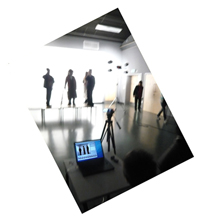The Story Teller's Apprentice
Bob and Bobita
Signage
A link to a collection of signs
that I collected over the summer to introduce this
group to the concept of silhouette.
The process of updating the story was in this case done by the whole group in a discussion, the story coming out of this discussion. A brief synopsis:
Bob and Bobita are leaving for school, their mother gives them money for breakfast, which they will buy on route from a fast food store. As they are walking they see an old lady with a zimmer frame, and help her to cross the road. They enter a McDonald’s and buy a McMuffin each, and are eating these as they continue on their way to school. But a hungry tramp approaches, attracted by the smell of the Mcmuffins. He grabs them and runs off. Seeing this, the old lady takes chase, corners him in a phone box, chastises him with her zimmer frame. She retrieves the Mcmuffins and returns them to Bob and Bobita, who continue on their way to school.


The first experiments, shown in these photographs, and in the trial animation above, were created while in a temporary classroom, by suspending a large white sheet across the middle of the entire room, and lighting it brightly from behind. A small low stage was then build behind the sheet. The second version of the piece was created once we had moved into our new studios, making use of the large white screen in the drama studio, lighting this brightly, and placing a stage in front of these lights. In this second version the teaching role was taken by Rachel, Ben-Yousef, as trainee teacher from the University of the West of England, who was with us for the latter part of the term.

The students used an application called ‘icananimate’ on an Apple Macbook, connected to a video camera. I had no problems getting the students to operate the cameras and to direct the action, but initially they were very reluctant to dress up and act, until we had use of the new drama studio.